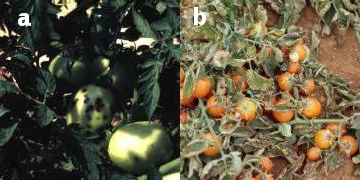Author:
David Francis, The Ohio State University

Figure 1. Bacterial Spot of tomato. (a) Bacterial spot symptoms on tomato fruit. (b) Defoliation due to bacterial spot. Photo credits: David Francis, The Ohio State University.
Introduction
Bacterial spot causes yield loss in tomato through reduced photosynthetic capacity and defoliation. Fruit quality is reduced indirectly due to sun-scald and directly by bacterial lesions. Bacterial spot of tomato is caused by as many as four species of Xanthomonas, including Xanthomonas euvesicatoria, X. vesicatoria, X. perforans, and X. gardneri. In addition, at least five physiological races—T1–T5—are recognized on the basis of a hypersensitive (HR) reaction on a differential series of host genotypes. Descriptions of bacterial spot may use the species names, taxonomic groups A–D, or race designations.
| Race | Species | Molecular Phylogeny | Comments | Resistant Germplasm |
|---|---|---|---|---|
| Race T1 | X. euvesicatoria | A group strains | Hawaii 7998, PI 114490 | |
| Race T2 | X. vesicatoria | B group strains | possibly also includes X. perforans, C group strains; X. euvesicatoria, A group strains; and X. gardneri, D group strains | PI 114490 |
| Race T3 | X. perforans | C group strains | possibly also includes X. gardneri, D group strains | Hawaii 7981, PI 128216, PI 126932 |
| Race T4 | X. perforans | C group strains | LA 716, PI 114490 | |
| Race T5 | X. perforans | C group strains |
References
- Jones, J. B., G. H. Lacy, H. Bouzar, G. V. Minsavage, R. E. Stall, and N. W. Schaad. 2005. Bacterial Spot – Worldwide distribution, importance and review. Acta Horticulturae (ISHS) 695: 27–34. (Available online at: http://www.actahort.org/books/695/695_1.htm) (verified 01 Mar 2012).
Additional Resources
- Miller, S. A., R. C. Rowe, and R. M. Riedel. 1996. Bacterial spot, speck, and canker of tomatoes. Factsheet HYG-3120-96. The Ohio State University Extension. Available online at: http://ohioline.osu.edu/hyg-fact/3000/3120.html (verified 01 Mar 2012).
- Momol, T., J. Jones, S. Olson, A. Obradovic, B. Balogh, and P. King. 2002. Integrated management of bacterial spot on tomato in Florida. Publication #PP192. University of Florida IFAS Extension. Available online at: http://edis.ifas.ufl.edu/pp110 (verified 01 Mar 2012).
- Sun, X., M. C. Nielsen, and J. W. Miller. 2002. Bacterial spot of tomato and pepper. Plant Pathology Circular No. 129 (revised) [Online]. Florida Department of Agriculture & Conservation Services. (Available at: http://www.doacs.state.fl.us/pi/enpp/pathology/pathcirc/pp129rev.pdf) (verified 01 Mar 2012).
- Asian Vegetable Research and Development Center Bacterial Spot (Xanthomonas campestris pv. vesicatoria) [Online]. AVRDC International Cooperators’ Fact Sheet. (Available at: http://www.avrdc.org/LC/tomato/bactspot.html) (verified 01 Mar 2012).
Funding Statement
Development of this lesson was supported in part by the National Institute of Food and Agriculture (NIFA) Solanaceae Coordinated Agricultural Project, agreement 2009-85606-05673, administered by Michigan State University. Any opinions, findings, conclusions, or recommendations expressed in this publication are those of the author(s) and do not necessarily reflect the view of the United States Department of Agriculture.
PBGworks 713
